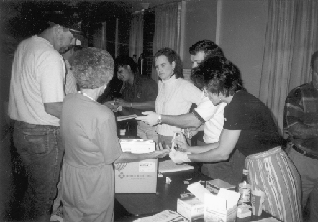 |
Health and Safety Fund to host
"Health Fair" at '98 Unity Conference The
Laborers' Health and Safety Fund of North America, is
scheduled to host a "Health Fair' at the 1998
Laborers' Unity Conference, March 20-22 in Madison. The
Fair is intended to provide members and their families
with on the spot preventive health screenings and other
informational services.
|
Protect yourself from high voltage
electrocutions
Construction workers are at risk of electrocution on the job.
Electrocutions cause 4% of LIUNA on-the-job deaths, 66% of which
are from contact with high voltage (over 600 volts).
Worksite sources of high voltage electricity are power lines,
electrical boxes, substations and conductors.
The Hazards
Laborers can come into contact with high voltage
electricity when loading and unloading materials, working around
power lines, electrical boxes and substations, drilling into
concealed conductors in walls or soil with jackhammers, and
trimming, felling or bucking trees with operating equipment.
(e.g., front-end loaders).
Workers often contact high voltage electrical conductors
directly, but most often the contact is made with ladders,
scaffolds, tools, rebar, pipe/conduits, metal beams, taglines,
aerial buckets or cranes.
Overhead power lines and transmission equipment pose very
serious hazards.
OSHA prohibits the operation of equipment within ten feet
(further for lines over 50 KV) of electrical distribution or
transmission lines rated 50 kilovolts or less - unless the lines
have been de-energized and visibly grounded at the point of work,
or insulating barriers have been installed.
What You Can Do
Only qualified electricians who have been instructed in
lockout procedures should work on high voltage sources.
Exercise extreme caution when working in the vicinity of power
lines. You must treat power lines as "hot" unless you
know they are property de-energized and grounded.
Electrical installations over 600 volts that are open to
unqualified persons must be surrounded with a metal enclosure or
enclosed in a vault and controlled by a lock.
Ensure that overcurrent devices are readily accessible and not
located where they create an employee safety hazard.
Ensure that fuses and circuit breakers are located or shielded
so that employees will not be burned or otherwise injured by
their operation (e.g., arcing).
Take Action
In order to protect yourself from electrocution, remember to:
- Verify that electrical lines are de-energized.
- Ensure that the line remains de-energized without a
lockout and tagout procedure.
- Use insulated protective equipment when working on or
near high voltage circuits.
- Keep a safe distance from energized lines.
Electricity is an extremely powerful tool. Keep it from
becoming a deadly one by recognizing hazards and taking the
necessary safety precautions.
Back to WI Laborers
